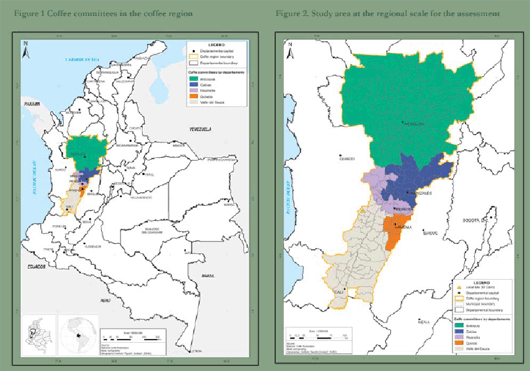Colombia
Ecological Function Assessment in the Colombian Andean Coffee-growing Region
Project Summary
The Andean Coffee-Growing Region assessment focused on Colombia’s main coffee region, which is located in the central part of the country in the Andean Mountains at an elevation between 1,000 and 2,000 meters above sea level. The regions included in the assessment are: Antioquia, Caldas, Risaralda, Quindío, and the Valle. These areas have both higher population density and higher economic activity than average for Colombia. Fifty percent of the land area is currently under human activities, such as cultivation, grazing, etc.
In this assessment a spatial temporal comparative study of several social, economic, demographic and environmental variables at different scales was undertaken. Change in land cover and phytosanitary factors were the direct drivers of change in the system. Indirect drivers in the system included demographic, economic and social-political factors. Human well-being indicators were based on the population’s overall quality of life. Ecosystem services were assessed according to supporting, provisioning, and cultural services. The relationships between drivers of ecosystem changes, ecosystem services and human well being were identified for the Colombian situation and include coffee related factors as well as others that might have an important effect on population well-being.
Ecosystem services
Ecosystems and their associated services have traditionally been undervalued and are often ignored in regional decision-making processes. The extent, location and trends in transformation to and from ecosystems were studied, as well as the location of rapid changes in the area. Supporting and provisioning services such as biodiversity and coffee production were also analysed. In 2002, Colombia was the third, out of 79, coffee producer country, with an important figure of 9% of the world production, representing around 805.000 has with an average production of 820 kg/ha. (Roldán 2003)
Assessment Approach
Ecosystem services were assessed at multiple spatial scales, including:
- national level: country level and the main coffee producing region examined;
- regional level: each one of the five departments analysed;
- local level: El Cairo coffee production municipality and a local window of 2,500 ha within it assessed as an in-depth pilot study
The assessment was initiated by constructing a database with available information on selected study areas. Many types of demographic, socio-economic, ecological, and technical (GIS, satellite maps, etc) tools and indicators were used for the database. During the database collection phase, outreach to stakeholders at multiple levels was conducted.
Indirect and direct drivers of ecosystem change were assessed for all of the study regions. These drivers were assessed at the three spatial scales.
Lead Institutions
The ecosystem assessment of the Colombian coffee-growing region was coordinated by two institutions: Alexander von Humboldt Biological Resource Research Institute and Cenicafė, the research branch of the National Federation of Coffee Growers. The ecosystem assessment was conducted as a pilot project and was self-funded.
Contact information
Focal Issues
Ecosystem services and human well-being of the region were analysed in order to determine the needs and direction of sustainable development in the region. The direct and indirect drivers of ecosystem and human well-being change were the primary focus of the assessment.
Ecosystems services assessed
Ecosystem and forest cover; agricultural production (coffee, food crop, cattle); water; ecotourism. Additionally, the effects of ecosystem services on biodiversity were assessed.
Project Outputs and Results

Results of the assessment indicated that 46% of coffee production in Colombia is based on the sun resistant Caturra variety. Traditional shade coffee systems and crop associated systems accounted for 54% of the coffee production. Antioquia had the most extensive area of land in coffee production (30%). Although small-scale, community-based growers dominate most of the region with properties under three hectares, over 50% of the coffee produced in Quindío was from farms larger than three hectares.
El Cairo was studied on the municipal level, where it was found that 33% of the total area was still under natural cover (although highly fragmented in the lower areas), and that the rest of the land area was dominated by shade grown coffee and other agricultural systems and pasture lands. Endangered bird and ant species were found in the study area of El Cairo. Forest and paramos experienced particularly high losses of area during the study period 1987-2000, but semi-natural ecosystems, especially in the form of pasture, increased significantly. Soils of the region had average to low fertility.
The correlation analysis indicate that transformed areas coincided with areas of high population density and high economic activity, clearly population and economic activity are influencing the transformation of natural cover to transformed ecosystems. On the other hand the areas better preserved coincide with lower values of quality life (according to the Index of quality life) and higher poverty areas. This results show how people transform the ecosystem looking for a better human well-being, nevertheless this way is unsustainable in the future.
Reports
Links
References
- Roldán, D., González, F., Salazar, M., 2003: La cadena del café en Colombia, documento de trabajo No 29. Ministerio de Agricultura y Desarrollo Rural -observatorio de agrocadenas Colombia. Bogotá – Colombia. Download